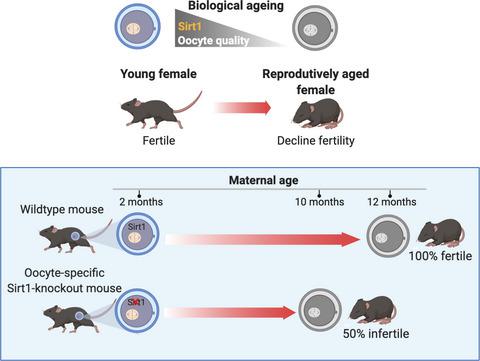当前位置:
X-MOL 学术
›
Aging Cell
›
论文详情
Our official English website, www.x-mol.net, welcomes your feedback! (Note: you will need to create a separate account there.)
Sirt1 sustains female fertility by slowing age-related decline in oocyte quality required for post-fertilization embryo development.
Aging Cell ( IF 7.8 ) Pub Date : 2020-07-30 , DOI: 10.1111/acel.13204 Juvita D Iljas 1 , Zhe Wei 1 , Hayden A Homer 1
Aging Cell ( IF 7.8 ) Pub Date : 2020-07-30 , DOI: 10.1111/acel.13204 Juvita D Iljas 1 , Zhe Wei 1 , Hayden A Homer 1
Affiliation

|
The NAD+‐dependent sirtuin deacetylase, Sirt1, regulates key transcription factors strongly implicated in ageing and lifespan. Due to potential confounding effects secondary to loss of Sirt1 function from the soma in existing whole‐animal mutants, the in vivo role of Sirt1 in oocytes (oocyte‐Sirt1) for female fertility remains unknown. We deleted Sirt1 specifically in growing oocytes and study how loss of oocyte‐Sirt1 affects a comprehensive range of female reproductive parameters including ovarian follicular reservoir, oocyte maturation, oocyte mitochondrial abundance, oxidative stress, fertilization, embryo development and fertility during ageing. Surprisingly, eliminating this key sirtuin from growing oocytes has no effect in young females. During a 10‐month‐long breeding trial, however, we find that 50% of females lacking oocyte‐Sirt1 become prematurely sterile between 9 and 11 months of age when 100% of wild‐type females remain fertile. This is not due to an accelerated age‐related decline in oocyte numbers in the absence of oocyte‐Sirt1 but to reduced oocyte developmental competence or quality. Compromised oocyte quality does not impact in vivo oocyte maturation or fertilization but leads to increased oxidative stress in preimplantation embryos that inhibits cleavage divisions. Our data suggest that defects emerge in aged females lacking oocyte‐Sirt1 due to concurrent age‐related changes such as reduced NAD+ and sirtuin expression levels, which compromise compensatory mechanisms that can cover for Sirt1 loss in younger oocytes. In contrast to evidence that increasing Sirt1 activity delays ageing, our data provide some of the only in vivo evidence that loss of Sirt1 induces premature ageing.
中文翻译:

Sirt1 通过减缓受精后胚胎发育所需的与年龄相关的卵母细胞质量下降来维持女性生育能力。
NAD +‐依赖的 Sirtuin 去乙酰化酶 Sirt1 调节与衰老和寿命密切相关的关键转录因子。由于现有的完整动物突变体中的体细胞失去 Sirt1 功能后潜在的混杂效应,Sirt1 在卵母细胞(卵母细胞 - Sirt1)中对女性生育能力的体内作用仍然未知。我们专门删除了生长中的卵母细胞中的 Sirt1,并研究了卵母细胞的丢失 - Sirt1 如何影响一系列女性生殖参数,包括卵巢滤泡库、卵母细胞成熟、卵母细胞线粒体丰度、氧化应激、受精、胚胎发育和衰老过程中的生育能力。令人惊讶的是,从生长的卵母细胞中消除这种关键的沉默调节蛋白对年轻女性没有影响。然而,在长达 10 个月的育种试验中,我们发现 50% 缺乏卵母细胞-Sirt1 的雌性在 9 到 11 个月大时过早地不育,而 100% 的野生型雌性仍能生育。这不是由于在没有卵母细胞-Sirt1 的情况下卵母细胞数量与年龄相关的加速下降,而是由于卵母细胞发育能力或质量降低。受损的卵母细胞质量不会影响体内卵母细胞的成熟或受精,但会导致植入前胚胎的氧化应激增加,从而抑制卵裂。我们的数据表明,由于同时发生的与年龄相关的变化(例如 NAD 降低),缺乏卵母细胞 - Sirt1 的老年女性会出现缺陷 这不是由于在没有卵母细胞-Sirt1 的情况下卵母细胞数量与年龄相关的加速下降,而是由于卵母细胞发育能力或质量降低。受损的卵母细胞质量不会影响体内卵母细胞的成熟或受精,但会导致植入前胚胎的氧化应激增加,从而抑制卵裂。我们的数据表明,由于同时发生的与年龄相关的变化(例如 NAD 降低),缺乏卵母细胞 - Sirt1 的老年女性会出现缺陷 这不是由于在没有卵母细胞-Sirt1 的情况下卵母细胞数量与年龄相关的加速下降,而是由于卵母细胞发育能力或质量降低。受损的卵母细胞质量不会影响体内卵母细胞的成熟或受精,但会导致植入前胚胎的氧化应激增加,从而抑制卵裂。我们的数据表明,由于同时发生的与年龄相关的变化(例如 NAD 降低),缺乏卵母细胞 - Sirt1 的老年女性会出现缺陷+和 sirtuin 表达水平,这会损害可以弥补年轻卵母细胞中 Sirt1 损失的补偿机制。与增加 Sirt1 活性延缓衰老的证据相反,我们的数据提供了一些唯一的体内证据,表明 Sirt1 的缺失会导致过早衰老。
更新日期:2020-09-24
中文翻译:

Sirt1 通过减缓受精后胚胎发育所需的与年龄相关的卵母细胞质量下降来维持女性生育能力。
NAD +‐依赖的 Sirtuin 去乙酰化酶 Sirt1 调节与衰老和寿命密切相关的关键转录因子。由于现有的完整动物突变体中的体细胞失去 Sirt1 功能后潜在的混杂效应,Sirt1 在卵母细胞(卵母细胞 - Sirt1)中对女性生育能力的体内作用仍然未知。我们专门删除了生长中的卵母细胞中的 Sirt1,并研究了卵母细胞的丢失 - Sirt1 如何影响一系列女性生殖参数,包括卵巢滤泡库、卵母细胞成熟、卵母细胞线粒体丰度、氧化应激、受精、胚胎发育和衰老过程中的生育能力。令人惊讶的是,从生长的卵母细胞中消除这种关键的沉默调节蛋白对年轻女性没有影响。然而,在长达 10 个月的育种试验中,我们发现 50% 缺乏卵母细胞-Sirt1 的雌性在 9 到 11 个月大时过早地不育,而 100% 的野生型雌性仍能生育。这不是由于在没有卵母细胞-Sirt1 的情况下卵母细胞数量与年龄相关的加速下降,而是由于卵母细胞发育能力或质量降低。受损的卵母细胞质量不会影响体内卵母细胞的成熟或受精,但会导致植入前胚胎的氧化应激增加,从而抑制卵裂。我们的数据表明,由于同时发生的与年龄相关的变化(例如 NAD 降低),缺乏卵母细胞 - Sirt1 的老年女性会出现缺陷 这不是由于在没有卵母细胞-Sirt1 的情况下卵母细胞数量与年龄相关的加速下降,而是由于卵母细胞发育能力或质量降低。受损的卵母细胞质量不会影响体内卵母细胞的成熟或受精,但会导致植入前胚胎的氧化应激增加,从而抑制卵裂。我们的数据表明,由于同时发生的与年龄相关的变化(例如 NAD 降低),缺乏卵母细胞 - Sirt1 的老年女性会出现缺陷 这不是由于在没有卵母细胞-Sirt1 的情况下卵母细胞数量与年龄相关的加速下降,而是由于卵母细胞发育能力或质量降低。受损的卵母细胞质量不会影响体内卵母细胞的成熟或受精,但会导致植入前胚胎的氧化应激增加,从而抑制卵裂。我们的数据表明,由于同时发生的与年龄相关的变化(例如 NAD 降低),缺乏卵母细胞 - Sirt1 的老年女性会出现缺陷+和 sirtuin 表达水平,这会损害可以弥补年轻卵母细胞中 Sirt1 损失的补偿机制。与增加 Sirt1 活性延缓衰老的证据相反,我们的数据提供了一些唯一的体内证据,表明 Sirt1 的缺失会导致过早衰老。



























 京公网安备 11010802027423号
京公网安备 11010802027423号